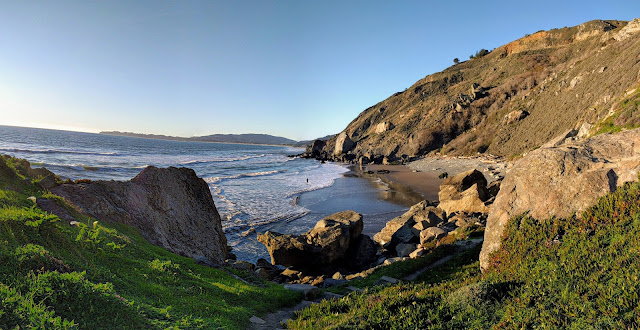Poison Oak
You are happily hopping along a narrow path, maybe enroute to your Steep Ravine campsite. But wait, there is something to be weary of.
The above path is edged with low growing poison oak. Northern California is awash in poison oak and as a hiker and nature lover, you just have to know how to live with it. Just be reasonable and not touch the greenery and exercise common sense and caution.
Despite being in so many zones which were poison oak landmines, I've never gotten the itch following a few simple rules:
1. Learn how to identify poison oak so you can recognize it immediately. It grows low and high (up to 40 feet). The leaves, branches, and roots can cause a rash.
2. Don't touch any plants that you don't know or plants growing together with species or branches you don't recognize.
3. Stay on main hiking paths (actually I've gone deep in the bush criss crossed with poison oak but have stayed safe with #4-#6.)
4. Wear long pants and socks. IMHO you are tempting fate with shorts and flip flops
5. Wash hiking clothes after you get home. Store them in a plastic bag if you are camping and take off said clothes before you get in the tent.
6. Don't freak out if you did touch, just wash your hands with detergent or liquid soap. DO NOT be that guy and use a soap bar unless of course it's a bar made esp. for poison oak. Actually I've had one for a decade unused and using dishwashing soap like Dawn is just as good. Also the first time you touch it, you may not get an immediate reaction as it takes up residence in your system. It's the second time that can cause a painful allergic rash where the poisonous oil urushiol has been exposed.
The leaves are oak shaped and redden through out the season but early on can be entirely green.
Poison oak is a California native that has a valuable role in the ecosystem. Many towhees nest among poison oak who eat the seeds and spread it good around California. Deers munch on it. And when it turns crimson red during the fall, poison oak adds beauty.
 |
| Stay in the middle! |
 |
| That's right, low growing poison oak edges this path. |
1. Learn how to identify poison oak so you can recognize it immediately. It grows low and high (up to 40 feet). The leaves, branches, and roots can cause a rash.
2. Don't touch any plants that you don't know or plants growing together with species or branches you don't recognize.
3. Stay on main hiking paths (actually I've gone deep in the bush criss crossed with poison oak but have stayed safe with #4-#6.)
4. Wear long pants and socks. IMHO you are tempting fate with shorts and flip flops
5. Wash hiking clothes after you get home. Store them in a plastic bag if you are camping and take off said clothes before you get in the tent.
6. Don't freak out if you did touch, just wash your hands with detergent or liquid soap. DO NOT be that guy and use a soap bar unless of course it's a bar made esp. for poison oak. Actually I've had one for a decade unused and using dishwashing soap like Dawn is just as good. Also the first time you touch it, you may not get an immediate reaction as it takes up residence in your system. It's the second time that can cause a painful allergic rash where the poisonous oil urushiol has been exposed.
The leaves are oak shaped and redden through out the season but early on can be entirely green.
Poison oak is a California native that has a valuable role in the ecosystem. Many towhees nest among poison oak who eat the seeds and spread it good around California. Deers munch on it. And when it turns crimson red during the fall, poison oak adds beauty.




Comments
Post a Comment